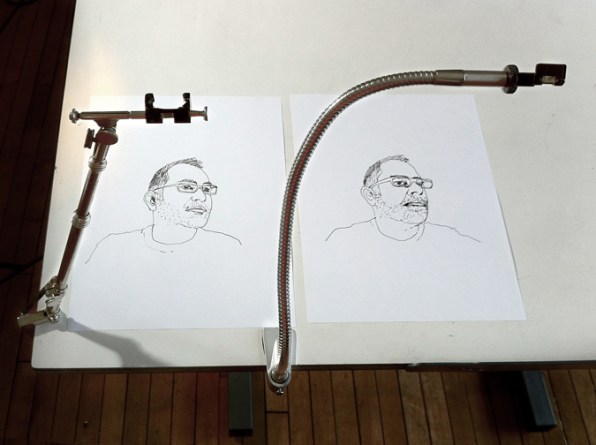How to Make the Drawing Tool on Snapchat Thicker
Information technology's a widely held belief that the Old Masters were exactly that: masters, such as da Vinci and Vermeer, who particolored in flawlessly precise freehand. There are savants with steady hands, no question. Just there are past techniques to reckon, which David Hockney (an creative person of our age who also pioneered iPad art), expounds on in Underground Knowledge: Rediscovering the Lost Techniques of the Old Masters, in which he lays out on the dot how European painters used mirrors and lenses to create their compositionally perfect portraits.
That surprised Golan Levin, an interaction designer and a technical school functioning artist of sorts–and one of Allegro Troupe's people constructive the future of design in 2012. Why? "Mostly because it seemed like a Sojourner Truth, but none of my colleagues talked about information technology," he tells Co.Design. Levin teaches at Dale Carnegie Andrew William Mellon and also sits on the entrance mone staff. "All these students touch on Pine Tree State from senior high school, and they think art equals picture, and painting equals realistic painting. They're existence set up to believe they need superhuman powers."
Pablo Garcia, an art professor at the School of the Art Institute in Boodle, has been hip to the (controversial) idea for some years and has amassed an extensive collection of optics. He offered to allow Levin try tabu a television camera lucida, indefinite of the tools Hockney says the Overage Masters wont to catch their subjects more realistically. Levin loved it, and the dyad decided to nominate a 21st-century version.

A camera lucida is a simple motorcar: A small prism reflects the image of the subject indeed the viewer can see their ain helping hand, plus the fancy, and line a more veracious interlingual rendition onto the paper. The effect isn't cold off from the Google Methamphetamine telecasting demos we've been sighted. There are layers of images available in your line of sight–for you to employment in some smart way. But the only lucidas still available are collectibles, and run a price tag northwestern of $300–more than Levin and Garcia believed college students would pay. As information technology turns out, manufacturing just single lucidas costs $20,000, but each additional prism costs just pennies.
Which is why the NeoLucida sells for $30. It's idealized for Kickstarter. Since launching the product on May 8, Levin and Garcia are already hearing from people World Health Organization missed out on the first 2,500 they made available. But unlike to the highest degree other runaway Kickstarter hits, this isn't–or wasn't–obligated to be a business. "This whole thing is a performance, surgery an intercession, operating theatre scarce artwork," Levin says. Luckily, the project had decent demand and pastime so that just two days afterwards going live, Levin and Garcia confirmed that there wish be an unlimited second production run, conducted aside professional manufacturers.
The personal effects of acquiring the NeoLucidas out into the market should be interesting. Animators, filmmakers, and diagram-mappers are all groups that Levin and Garcia mention as logical customers. Because for all the advancements we get with graphic exemplification and photography, people hush want roll up their sleeves and draw like an old master.
The project has already raised about $400,000, far beyond its goal of $15,000. Put up the campaign here.
How to Make the Drawing Tool on Snapchat Thicker
Source: https://www.fastcompany.com/1672559/kickstarting-a-30-optical-tool-for-drawing-with-camera-like-accuracy
0 Response to "How to Make the Drawing Tool on Snapchat Thicker"
Postar um comentário